| |

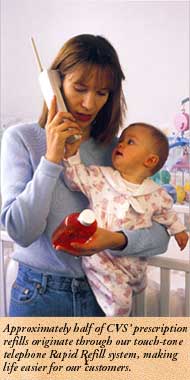 We also continue to make significant progress on our next-generation Rx2000 Pharmacy Delivery
Project, which is reengineering the way we fill prescriptions. This project is designed to
enhance pharmacy productivity, lower costs and improve service by enabling our pharmacists to
spend more time with customers. A key benefit of our approach is that it is scalable: we can
tailor our system for the needs of specific stores. For example, we will roll out automated
pill-counting only in our high volume stores that can justify the investment, while all stores
will receive integrated workflow improvements. This approach, versus "one size fits all," is
just one more example of our focus on maximizing our return on invested capital.
We also continue to make significant progress on our next-generation Rx2000 Pharmacy Delivery
Project, which is reengineering the way we fill prescriptions. This project is designed to
enhance pharmacy productivity, lower costs and improve service by enabling our pharmacists to
spend more time with customers. A key benefit of our approach is that it is scalable: we can
tailor our system for the needs of specific stores. For example, we will roll out automated
pill-counting only in our high volume stores that can justify the investment, while all stores
will receive integrated workflow improvements. This approach, versus "one size fits all," is
just one more example of our focus on maximizing our return on invested capital.

The growth of managed care has been very favorable to CVS. Our strong presence in local
markets and our advanced technology systems enable us to provide unique prescription benefit
management (PBM) services. This has made us a partner of choice for many managed care
organizations.
PharmaCare®, our pharmacy benefit management company, was formed in 1994 and, since that
time, has grown to achieve solid profitability while becoming one of the top ten PBMs in the
nation. PharmaCare’s objective is to enable its customers— primarily managed care
organizations—to deliver the best healthcare to their members in the most cost-effective manner.
To achieve this, PharmaCare takes advantage of its unique position in the healthcare continuum;
specifically, its relationship with CVS and the ability of CVS pharmacists to interact directly
with patients and physicians to facilitate clinical management. PharmaCare developed its
Clinical Information Management System (CIMS), a proprietary formulary management tool and
unique communication system that has proven to be tremendously effective in directing
utilization to the most appropriate and cost-effective medications.
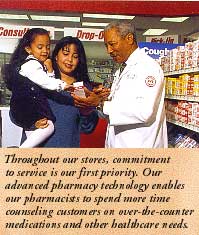 More than 30,000 physicians now participate in CIMS, making it a leading formulary compliance
tool that provides us with a key competitive advantage in attracting managed care customers. In
1998, PharmaCare began implementing managed care contracts covering more than two million lives,
including programs for the Department of Defense (Champus) and several leading health maintenance
organizations (HMOs), such as Health Partners of Minneapolis. With these contracts, PharmaCare
will manage prescription services for more than six million lives. PharmaCare’s ability to
garner new contracts helps drive CVS’ core business, as evidenced by our industry-leading
pharmacy sales growth. With more and more consumers becoming part of managed care programs, we
expect this segment of our business to continue to grow.
More than 30,000 physicians now participate in CIMS, making it a leading formulary compliance
tool that provides us with a key competitive advantage in attracting managed care customers. In
1998, PharmaCare began implementing managed care contracts covering more than two million lives,
including programs for the Department of Defense (Champus) and several leading health maintenance
organizations (HMOs), such as Health Partners of Minneapolis. With these contracts, PharmaCare
will manage prescription services for more than six million lives. PharmaCare’s ability to
garner new contracts helps drive CVS’ core business, as evidenced by our industry-leading
pharmacy sales growth. With more and more consumers becoming part of managed care programs, we
expect this segment of our business to continue to grow.

CVS’ strategy for success is rooted in our belief that we can offer value to customers by
differentiating our merchandising and marketing of key destination categories, including
beauty and cosmetics, photofinishing, greeting cards, over-the-counter drugs, seasonal merchandise
and CVS brand products. These core businesses—coupled with our ability to tailor stores to the
local communities they serve—will be key factors contributing to CVS’ continued success.
|
We continually look for ways to make our product assortments and services more appealing to
customers. In the beauty category, for example, CVS was the first drugstore chain to launch a
money-back guarantee on cosmetics. We also recognized the popularity and potential of key
brands that typically have not been sold in drugstores. For example, Ultima II cosmetics,
formerly only available in department stores, have now been introduced in 3,000 of our stores.
As a result of these and other customer-focused initiatives, sales in the beauty category
increased 30% last year. We are actively exploring general merchandise sales opportunities
to drive sales of these products that appeal to customers. We are also taking steps in other
categories, such as photofinishing, where we plan to have one-hour photo labs installed in
2,000 stores by the end of 1999. In greeting cards,
we continue to increase productivity by working with our vendors to refine our assortments
and in-store displays. During the 1998 holiday season, CVS generated a high level of consumer
excitement with its promotion of an exclusive line of "misfit" beanbag characters. The
characters were inspired by the annual television special, "Rudolph the Red-Nosed Reindeer"*
and its "Island of Misfit Toys."* We introduced two new characters each week between
Thanksgiving and Christmas. Through the promotion of this limited edition, we created a special
"buzz" in our stores throughout the holidays.
|

|
® 1998 ©
The Rudolph Co., LP,
under license to GT
Merchandising &
Licensing Corp.
|
 Our CVS brand merchandise has also proven to be a major draw for customers. By offering
high-quality products at excellent prices, the CVS brand continues to be extremely successful,
posting double-digit sales increases. As part of our expansion, we recently added CVS brand
herbal and natural supplements to enhance our line of private label vitamins, a fast-growing
category. We also continue to expand our line of successful CVS Gold Emblem® convenience food
products. The Gold Emblem name signifies our commitment to superior quality and exceptional
value.
Our CVS brand merchandise has also proven to be a major draw for customers. By offering
high-quality products at excellent prices, the CVS brand continues to be extremely successful,
posting double-digit sales increases. As part of our expansion, we recently added CVS brand
herbal and natural supplements to enhance our line of private label vitamins, a fast-growing
category. We also continue to expand our line of successful CVS Gold Emblem® convenience food
products. The Gold Emblem name signifies our commitment to superior quality and exceptional
value.
Just as in our pharmacy business, investments in technology have played a valuable role in
optimizing our front-store performance. One of our most important programs is our multi-year
supply chain initiative. This multi-year initiative will totally transform the way we receive,
distribute and sell merchandise in the future. It is helping us improve our in-stock positions
as well as our sell-throughs of promotional and seasonal merchandise. The first two phases of
this initiative focused on making improvements in our category management system and in
maximizing gross profit through price elasticity and promotional allocations. During the
third phase, we are launching a merchandise transaction system that will help us more
effectively tailor our product mix for specific markets, an increasingly important part of
our strategy. Based on test programs, we believe there is a significant opportunity to further
increase front-store sales through "micromerchandising" initiatives that enable us to better
respond to the particular needs and tastes of customers in local markets.

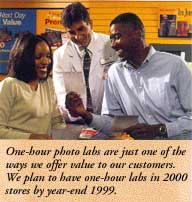 In total, it is our superior knowledge of our customers’ needs and our endless search for better
ways to serve them, our tailoring of stores to local tastes, our advanced technology, and our
talented people that drive our superior execution at retail.
In total, it is our superior knowledge of our customers’ needs and our endless search for better
ways to serve them, our tailoring of stores to local tastes, our advanced technology, and our
talented people that drive our superior execution at retail.

The relocation of existing stores to new freestanding sites also represents a major growth
opportunity for CVS. We typically see a significant increase in sales and profits when a store
is moved from an "in-line" site in a shopping center to a freestanding format, as consumers use
the store differently. Currently, 23% of our store base is freestanding. We believe the entire
chain will ultimately be comprised of 70-80% freestanding/convenience locations. As a result,
we will concentrate our new store efforts on obtaining prime locations for freestanding stores.
 Expansion in key urban markets will also be a priority. We have proven our ability to operate
successfully in markets such as Washington, D.C., and Boston, and we see excellent potential
in urban areas that are underpenetrated, such as Philadelphia, Cleveland and New York City. We
have already been expanding aggressively in New York City, where we currently operate
approximately 60 stores. Our goal is to have 150-200 stores in the city’s five boroughs within
the next few years. As part of this strategy, we acquired 16 well-located stores from Thriftway
Pharmacy in 1998. These sites have already been converted to CVS stores and are achieving strong
results.
Expansion in key urban markets will also be a priority. We have proven our ability to operate
successfully in markets such as Washington, D.C., and Boston, and we see excellent potential
in urban areas that are underpenetrated, such as Philadelphia, Cleveland and New York City. We
have already been expanding aggressively in New York City, where we currently operate
approximately 60 stores. Our goal is to have 150-200 stores in the city’s five boroughs within
the next few years. As part of this strategy, we acquired 16 well-located stores from Thriftway
Pharmacy in 1998. These sites have already been converted to CVS stores and are achieving strong
results.

The mission of CVS is to help people live longer, healthier, happier lives. We strive to fulfill
this mission not only in the way we do business, but also through our corporate contributions
and community involvement programs. Our charitable giving activities demonstrate the core values
of our business: teamwork, openness, and willingness to embrace change. Whether it’s a team of
CVS volunteers walking to raise money for the American Cancer Society, a pharmacist who spends
time each week at a housing facility for the elderly talking to residents about drug
interactions, or a market-wide initiative to promote education and information to first-time
parents about child development, CVS is reaching out to others.
|
In addition to developing health programs for our customers and identifying nonprofit partners
to promote awareness and education on health issues, CVS invests in educational initiatives that
educate our youth and help prepare them for the future. From scholarships to innovative school
reform grants—CVS is engaging its colleagues, enlightening young minds and bringing together
educators in a collaborative effort to improve our education system. CVS focuses on curriculum
reform, encourages the use of new teaching techniques and supports professional development for
secondary-school teachers. We are particularly proud of the level of community involvement
demonstrated by our associates.
|
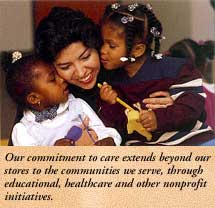
|

|

|
|

|
| Alabama |
|
144 |
| Connecticut |
122 |
| Delaware |
3 |
| Florida |
22 |
| Georgia |
304 |
| Illinois |
70 |
| Indiana |
291 |
| Kentucky |
71 |
| Maine |
20 |
| Maryland |
170 |
| Massachusetts |
321 |
| Michigan |
225 |
| New Hampshire |
29 |
| New Jersey |
183 |
| New York |
363 |
| North Carolina |
296 |
| Ohio |
414 |
| Pennsylvania |
319 |
| Rhode Island |
52 |
| South Carolina |
196 |
| Tennessee |
146 |
| Vermont |
2 |
| Virginia |
253 |
| Washington, D.C. |
47 |
| West Virginia |
59 |
|

Download this section in PDF format.
|

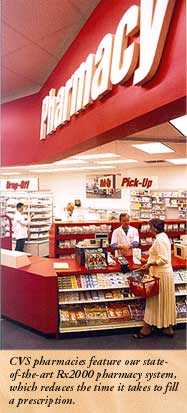
![]()

 We also continue to make significant progress on our next-generation Rx2000 Pharmacy Delivery
Project, which is reengineering the way we fill prescriptions. This project is designed to
enhance pharmacy productivity, lower costs and improve service by enabling our pharmacists to
spend more time with customers. A key benefit of our approach is that it is scalable: we can
tailor our system for the needs of specific stores. For example, we will roll out automated
pill-counting only in our high volume stores that can justify the investment, while all stores
will receive integrated workflow improvements. This approach, versus "one size fits all," is
just one more example of our focus on maximizing our return on invested capital.
We also continue to make significant progress on our next-generation Rx2000 Pharmacy Delivery
Project, which is reengineering the way we fill prescriptions. This project is designed to
enhance pharmacy productivity, lower costs and improve service by enabling our pharmacists to
spend more time with customers. A key benefit of our approach is that it is scalable: we can
tailor our system for the needs of specific stores. For example, we will roll out automated
pill-counting only in our high volume stores that can justify the investment, while all stores
will receive integrated workflow improvements. This approach, versus "one size fits all," is
just one more example of our focus on maximizing our return on invested capital.
 More than 30,000 physicians now participate in CIMS, making it a leading formulary compliance
tool that provides us with a key competitive advantage in attracting managed care customers. In
1998, PharmaCare began implementing managed care contracts covering more than two million lives,
including programs for the Department of Defense (Champus) and several leading health maintenance
organizations (HMOs), such as Health Partners of Minneapolis. With these contracts, PharmaCare
will manage prescription services for more than six million lives. PharmaCare’s ability to
garner new contracts helps drive CVS’ core business, as evidenced by our industry-leading
pharmacy sales growth. With more and more consumers becoming part of managed care programs, we
expect this segment of our business to continue to grow.
More than 30,000 physicians now participate in CIMS, making it a leading formulary compliance
tool that provides us with a key competitive advantage in attracting managed care customers. In
1998, PharmaCare began implementing managed care contracts covering more than two million lives,
including programs for the Department of Defense (Champus) and several leading health maintenance
organizations (HMOs), such as Health Partners of Minneapolis. With these contracts, PharmaCare
will manage prescription services for more than six million lives. PharmaCare’s ability to
garner new contracts helps drive CVS’ core business, as evidenced by our industry-leading
pharmacy sales growth. With more and more consumers becoming part of managed care programs, we
expect this segment of our business to continue to grow.

 Our CVS brand merchandise has also proven to be a major draw for customers. By offering
high-quality products at excellent prices, the CVS brand continues to be extremely successful,
posting double-digit sales increases. As part of our expansion, we recently added CVS brand
herbal and natural supplements to enhance our line of private label vitamins, a fast-growing
category. We also continue to expand our line of successful CVS Gold Emblem® convenience food
products. The Gold Emblem name signifies our commitment to superior quality and exceptional
value.
Our CVS brand merchandise has also proven to be a major draw for customers. By offering
high-quality products at excellent prices, the CVS brand continues to be extremely successful,
posting double-digit sales increases. As part of our expansion, we recently added CVS brand
herbal and natural supplements to enhance our line of private label vitamins, a fast-growing
category. We also continue to expand our line of successful CVS Gold Emblem® convenience food
products. The Gold Emblem name signifies our commitment to superior quality and exceptional
value.

 In total, it is our superior knowledge of our customers’ needs and our endless search for better
ways to serve them, our tailoring of stores to local tastes, our advanced technology, and our
talented people that drive our superior execution at retail.
In total, it is our superior knowledge of our customers’ needs and our endless search for better
ways to serve them, our tailoring of stores to local tastes, our advanced technology, and our
talented people that drive our superior execution at retail.
 Expansion in key urban markets will also be a priority. We have proven our ability to operate
successfully in markets such as Washington, D.C., and Boston, and we see excellent potential
in urban areas that are underpenetrated, such as Philadelphia, Cleveland and New York City. We
have already been expanding aggressively in New York City, where we currently operate
approximately 60 stores. Our goal is to have 150-200 stores in the city’s five boroughs within
the next few years. As part of this strategy, we acquired 16 well-located stores from Thriftway
Pharmacy in 1998. These sites have already been converted to CVS stores and are achieving strong
results.
Expansion in key urban markets will also be a priority. We have proven our ability to operate
successfully in markets such as Washington, D.C., and Boston, and we see excellent potential
in urban areas that are underpenetrated, such as Philadelphia, Cleveland and New York City. We
have already been expanding aggressively in New York City, where we currently operate
approximately 60 stores. Our goal is to have 150-200 stores in the city’s five boroughs within
the next few years. As part of this strategy, we acquired 16 well-located stores from Thriftway
Pharmacy in 1998. These sites have already been converted to CVS stores and are achieving strong
results.


